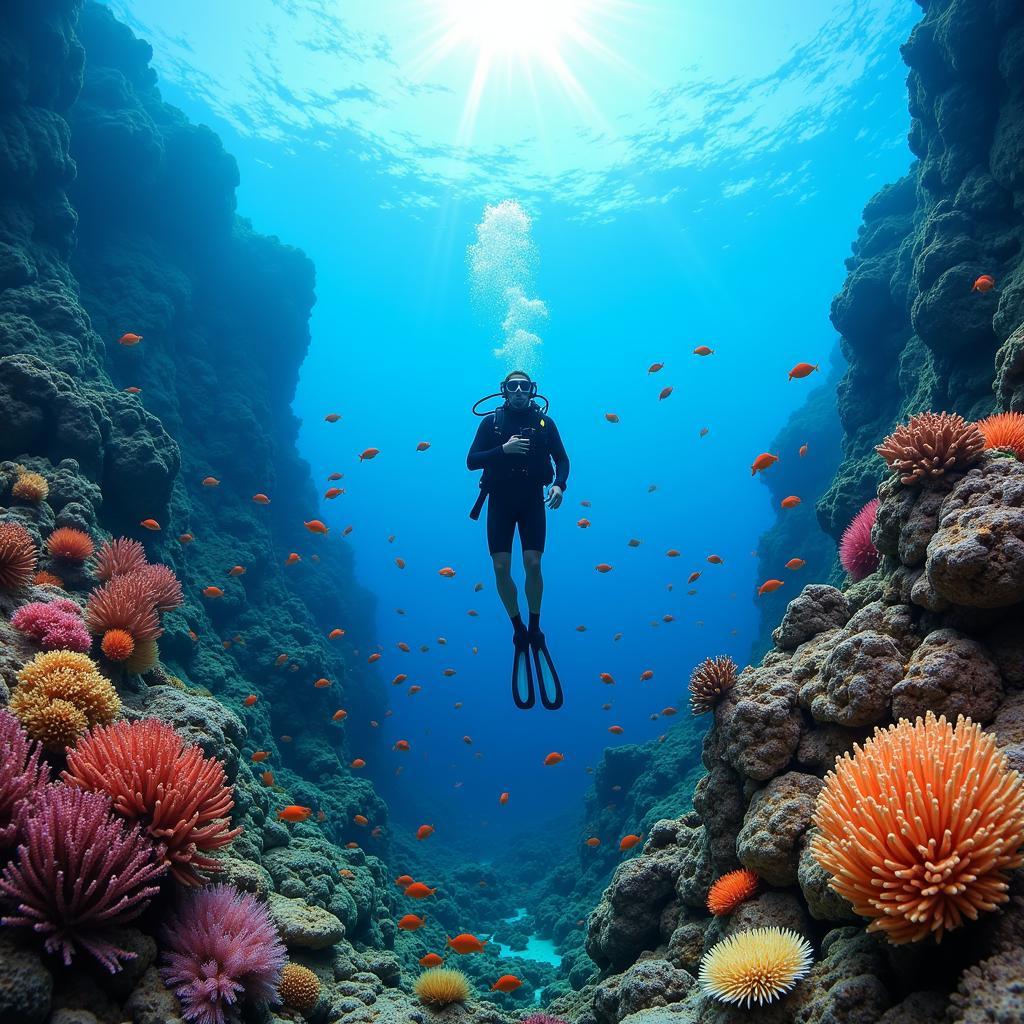Extreme sports push the boundaries of human capability, offering adrenaline-pumping experiences that defy gravity and convention. Whether you’re a seasoned adventurer or an armchair enthusiast, understanding the terminology of these thrilling activities can deepen your appreciation and connect you with the global community of extreme sports lovers. This article delves into the vibrant world of extreme sports, exploring their diverse vocabulary in English.
Diving into the Depths of Water Sports
Water offers a unique playground for extreme sports, from the depths of the ocean to the crashing waves of the coast. Scuba diving, with its specialized equipment and focus on underwater exploration, reveals the hidden beauty of marine life. Free diving, on the other hand, tests the limits of human endurance as divers descend without any breathing apparatus. Surfing, windsurfing, and kitesurfing harness the power of the wind and waves, providing exhilarating rides and breathtaking aerial maneuvers.
While these sports demand skill and precision, they also offer a sense of freedom and connection with nature. The thrill of riding a massive wave or exploring a hidden shipwreck is unparalleled. The specific vocabulary associated with each sport adds another layer of fascination, allowing enthusiasts to communicate effectively and share their passion. For example, in surfing, terms like “barrel,” “cutback,” and “offshore” paint vivid pictures of the action.
Taking to the Skies: Aerial Adventures
The allure of the open sky has always captivated humans, and extreme sports offer innovative ways to experience the thrill of flight. BASE jumping, a particularly daring activity, involves leaping from fixed objects like buildings, antennas, spans (bridges), and earth (cliffs), with a parachute deployed just seconds before impact. Skydiving, a more established and accessible aerial sport, offers the exhilarating sensation of freefall before the parachute opens, providing stunning views and an unforgettable adrenaline rush. Similar to the excitement offered by baán dù lượn thể thao, paragliding allows pilots to soar through the air using a wing-shaped parachute, taking advantage of wind currents to stay aloft for extended periods.
These aerial sports offer a unique perspective on the world, allowing participants to conquer their fears and experience the sheer joy of flight. From the technical jargon of BASE jumping to the more familiar terms of skydiving, understanding the language of these sports allows for a deeper appreciation of the skills and courage required.
Conquering Land and Ice: Earthbound Thrills
The Earth itself provides a diverse range of environments for extreme sports enthusiasts. Mountain biking pushes the limits of physical endurance and technical skill as riders navigate challenging terrains, from steep descents to rocky climbs. Rock climbing, with its focus on strength, agility, and problem-solving, offers a rewarding challenge for both mind and body. Ice climbing takes this challenge to a new level, requiring specialized equipment and techniques to ascend frozen waterfalls and ice formations.
Just like the thrill found in lịch chiếu đài htv thể thao, the diverse landscape of extreme sports on land provides opportunities for adventure and personal growth. From the technical vocabulary of rock climbing to the slang used by mountain bikers, each sport has its own unique language that contributes to the sense of community and shared experience. Imagine discussing “crux moves” or “dynos” with fellow climbers – it’s a language that connects and inspires.
Why Learn the Lingo of Extreme Sports?
Understanding the specific terms used in extreme sports isn’t just about expanding your vocabulary. It also enhances your appreciation for the skills and challenges involved. It allows you to connect with the global community of enthusiasts and engage in meaningful conversations about these thrilling activities. Whether you are watching documentaries, reading articles like báo thể thao 287 22 âu dương lân, or following your favorite athletes, knowing the lingo unlocks a deeper understanding and enjoyment of the extreme sports world.
Conclusion
From the depths of the ocean to the peaks of mountains, extreme sports offer a diverse range of thrilling experiences. By learning the specific vocabulary associated with these activities, you gain a deeper appreciation for the skills, challenges, and passion that drive extreme sports enthusiasts around the world. This vocabulary is the key to unlocking a world of adventure and connecting with a global community. So, dive in, take flight, and conquer the challenges – the world of extreme sports awaits!
FAQ
-
What are some examples of extreme winter sports?
Snowboarding, skiing, ice climbing, and snowmobiling are all considered extreme winter sports. -
What is the difference between BASE jumping and skydiving?
BASE jumping involves leaping from fixed objects, while skydiving involves jumping from an aircraft. -
What equipment is needed for scuba diving?
Essential scuba diving equipment includes a mask, fins, a regulator, a buoyancy compensator device (BCD), and a tank. -
How can I learn more about extreme sports?
You can find information about extreme sports through documentaries, books, websites, and by joining local clubs or organizations. -
What are some of the risks associated with extreme sports?
Extreme sports carry inherent risks, including injuries, accidents, and even fatalities. Proper training and safety precautions are essential. -
Are there any age restrictions for extreme sports?
Age restrictions vary depending on the specific sport and the regulations of the organizing body. -
What is the most dangerous extreme sport?
Many consider BASE jumping to be the most dangerous extreme sport due to the high risk of fatality.
When you need any support for extreme sports or the latest news similar to bộ quần áo gió chống nước thể thao nam and giày thể thao lv nữ chính hãng, please contact Phone Number: 0372999996, Email: [email protected] Or visit us at: 236 Cau Giay, Hanoi. We have a 24/7 customer service team.

Để lại một bình luận